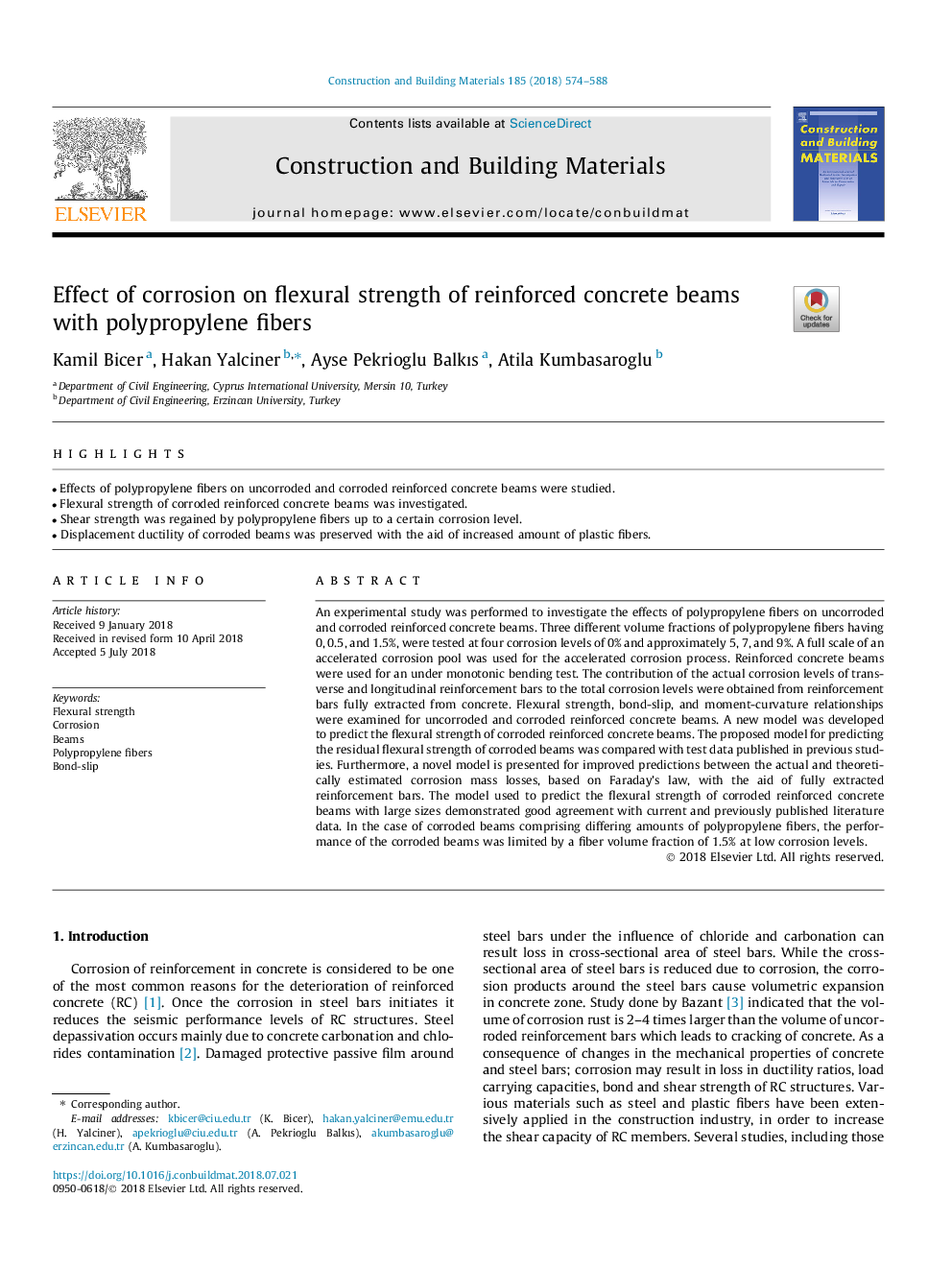| کد مقاله | کد نشریه | سال انتشار | مقاله انگلیسی | نسخه تمام متن |
|---|---|---|---|---|
| 6711998 | 1428721 | 2018 | 15 صفحه PDF | دانلود رایگان |
عنوان انگلیسی مقاله ISI
Effect of corrosion on flexural strength of reinforced concrete beams with polypropylene fibers
ترجمه فارسی عنوان
اثر خوردگی بر روی مقاومت خمشی تیرهای بتونی تقویت شده با الیاف پلی پروپیلن
دانلود مقاله + سفارش ترجمه
دانلود مقاله ISI انگلیسی
رایگان برای ایرانیان
کلمات کلیدی
استحکام خمشی، خوردگی، پرتوهای، الیاف پلی پروپیلن، لغزش باند،
ترجمه چکیده
یک مطالعه تجربی برای بررسی اثرات فیبرهای پلی پروپیلن بر روی تیرهای بتونی تقویت نشده و آهنی خورده انجام شد. سه قطعه مختلف حجمی از فیبرهای پلی پروپیلن حاوی 0، 0.5 و 1.5٪ در چهار سطح خوردگی 0٪ و حدود 5، 7 و 9٪ مورد آزمایش قرار گرفتند. مقیاس کامل یک استخر خوردگی سریع برای استفاده از فرآیند خوردگی سریع استفاده شد. تیرهای بتونی تقویت شده برای آزمون خمشی مونوونیون استفاده شد. سهم سطح واقعی خوردگی میله های تقویتی عرضی و طولی به سطح خوردگی کامل از میله های تقویت کننده به طور کامل از بتن استخراج شده است. مقاومت فشاری، لغزش باند و انحنای لحظه ای برای تیرهای بتونی تقویت نشده و کروی شده بررسی شده است. یک مدل جدید برای پیش بینی مقاومت خمشی از تیرهای بتونی خورده خورده است. مدل پیشنهادی برای پیش بینی مقاومت خمشی باقی مانده از پرتوهای خورنده با داده های آزمایش شده در مطالعات قبلی مقایسه شده است. علاوه بر این، یک مدل جدید برای پیش بینی های بهتر بین تخمین های تخمین زده شده واقعی و تخمین زده شده از نظر خوردگی بر اساس قانون فارادی با کمک میله های تقویت شده به طور کامل استخراج ارائه شده است. مدل مورد استفاده برای پیش بینی مقاومت خمشی تیرهای بتونی خورنده با اندازه های بزرگ توافق خوبی با داده های موجود و ادبیات منتشر شده دارد. در مورد پرتوهای خورنده حاوی مقادیر مختلف فیبرهای پلی پروپیلن، عملکرد تیرهای خورنده توسط مقدار کریستالی 1.5٪ در سطوح پایین خوردگی محدود شده است.
موضوعات مرتبط
مهندسی و علوم پایه
سایر رشته های مهندسی
مهندسی عمران و سازه
چکیده انگلیسی
An experimental study was performed to investigate the effects of polypropylene fibers on uncorroded and corroded reinforced concrete beams. Three different volume fractions of polypropylene fibers having 0, 0.5, and 1.5%, were tested at four corrosion levels of 0% and approximately 5, 7, and 9%. A full scale of an accelerated corrosion pool was used for the accelerated corrosion process. Reinforced concrete beams were used for an under monotonic bending test. The contribution of the actual corrosion levels of transverse and longitudinal reinforcement bars to the total corrosion levels were obtained from reinforcement bars fully extracted from concrete. Flexural strength, bond-slip, and moment-curvature relationships were examined for uncorroded and corroded reinforced concrete beams. A new model was developed to predict the flexural strength of corroded reinforced concrete beams. The proposed model for predicting the residual flexural strength of corroded beams was compared with test data published in previous studies. Furthermore, a novel model is presented for improved predictions between the actual and theoretically estimated corrosion mass losses, based on Faraday's law, with the aid of fully extracted reinforcement bars. The model used to predict the flexural strength of corroded reinforced concrete beams with large sizes demonstrated good agreement with current and previously published literature data. In the case of corroded beams comprising differing amounts of polypropylene fibers, the performance of the corroded beams was limited by a fiber volume fraction of 1.5% at low corrosion levels.
ناشر
Database: Elsevier - ScienceDirect (ساینس دایرکت)
Journal: Construction and Building Materials - Volume 185, 10 October 2018, Pages 574-588
Journal: Construction and Building Materials - Volume 185, 10 October 2018, Pages 574-588
نویسندگان
Kamil Bicer, Hakan Yalciner, Ayse Pekrioglu Balkıs, Atila Kumbasaroglu,
